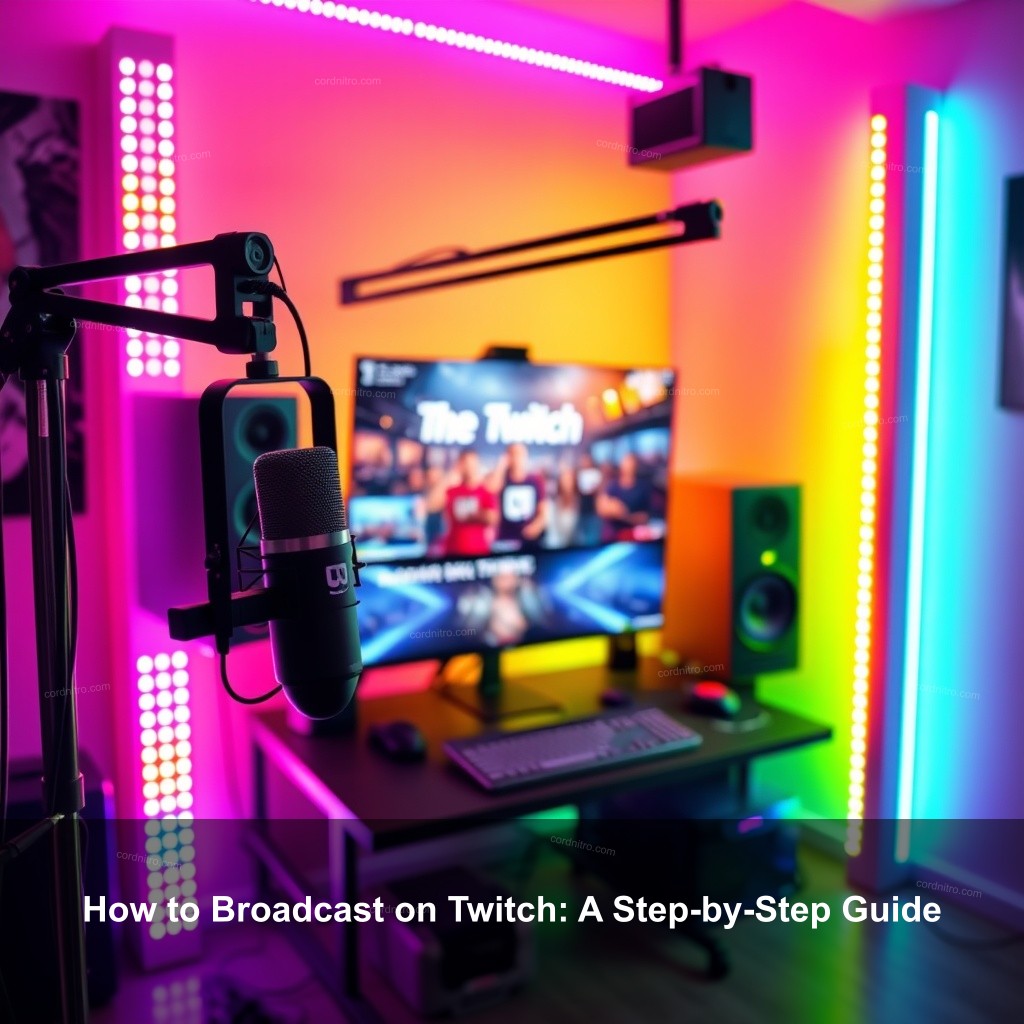Did you know that Twitch has over 140 million monthly active users? If you want to join the ranks of successful streamers, understanding how to broadcast on Twitch is important. In this guide, we’ll cover everything you need to know about setting up your Twitch broadcast, including the equipment required, software options, and tips for engaging your audience. Whether you’re a newbie or looking to enhance your streaming skills, this guide is just for you!

How to Broadcast on Twitch: A Step-by-Step Guide
When it comes to broadcasting on Twitch, the first step is to create a solid foundation with your account setup. Here’s how to get started.
Creating Your Twitch Account
Setting up your Twitch account is straightforward, but it’s crucial to get it right from the beginning. You want to make sure your account stands out and is secure.
To start, visit the Twitch website and click on the ‘Sign Up’ button. You’ll need to provide a username, password, and email address. Make sure to choose a username that reflects your brand or personality, as this is how viewers will identify you.
Enabling Two-Factor Authentication (2FA) comes second after you have registered. This gives your account even more protection from illegal access. Creating 2FA is easy. Click Security and Privacy from your account settings, then follow the directions to link your phone number or email for verification.
Now that your account is secure, it’s time to explore the Twitch interface. Familiarize yourself with the main dashboard, where you can manage your streams, engage with your audience, and track your statistics.
Essential Equipment for Streaming
Your streaming setup plays a massive role in the quality of your broadcast. Here’s what you need to consider.
| Equipment | Importance | Recommendations |
|---|---|---|
| Computer | Enables smooth streaming performance | Intel Core i5 or better, 8GB RAM |
| Microphone | Ensures clear audio | Blue Yeti or Audio-Technica AT2020 |
| Webcam | Enhances visual quality | Logitech C920 or similar |
| Lighting | Improves video quality | Softbox lights or LED panels |
Make sure your streaming environment is also maximized lastly. The professionalism of your broadcast will be much improved by good lighting and a neat background. Think about lighting your face during broadcasting using softbox lights or from natural light.
Setting Up Your Twitch Broadcast
With your account and equipment ready, it’s time to set up your broadcast.
Choosing the Right Streaming Software
Your choice of streaming software can greatly influence your Twitch experience. There are several options, but OBS Studio and Streamlabs OBS are the most popular among streamers.
Beginning users would find OBS Studio a fantastic option since it is free and open-source. It lets one extensively customize and supports several plugins. Conversely, Streamlabs OBS provides built-in alarms and overlays together with a more user-friendly interface.
Installing either program is easy. Simply download the software from their official website, follow the installation instructions, and you’ll be up and running in no time.
You can begin adjusting your streaming parameters once installed. To guarantee seamless broadcasting and match your internet connection, be sure you choose the right quality and bitrate. Based on your upload speed, Twitch suggests a bitrate for 1080p broadcasting between 3000 and 6000 kbps.
Twitch Broadcasting Settings
Stream settings are important for a successful broadcast. It’s crucial to get these right as they influence your stream quality and viewer experience.
Start by checking your internet speed. You can use tools like Speedtest to determine your upload speed. If your upload speed is less than 5 Mbps, consider lowering your stream resolution to 720p.
Configure your audio and video options in your streaming program next. Choose the right audio device for your microphone and adjust the video resolution to your capability. Recall that good audio is equally crucial as top-notch visuals.
Before you go live, run a test stream. This allows you to check your audio levels, video quality, and internet connection stability. You can also ask a friend to join your stream and provide feedback on any issues they notice.

Engaging with Your Audience on Twitch
Once your broadcast is up and running, it’s essential to engage with your audience effectively.
Building a Community
Expanding your Twitch channel calls for engagement. Engage conversation viewers first to start. Urge people to contribute ideas and ask questions during your stream. Along with making the experience more interactive, this fosters a supporting community.
Consider using Twitch’s moderation features to help manage chat. Assign trusted moderators to ensure that your chat remains friendly and inclusive. This allows you to focus on content while they handle any problematic comments.
Conducting surveys or prizes is another excellent approach to involve. Asking viewers to vote on what game they should play next or providing awards for participation will help them to become involved. These strategies can greatly raise viewers’ involvement and allegiance.
Monetizing Your Twitch Channel
As you grow your community, consider monetization options. One straightforward way to earn is through donations. Platforms like PayPal and Streamlabs allow viewers to contribute directly to your stream.
You can also set up subscriptions for your channel. Twitch offers various subscription tiers that provide perks to subscribers, like exclusive emotes and ad-free viewing. Promote these subscriptions during your stream to encourage more viewers to support you.
Examine sponsorship prospects last. Companies can start seeking new alliances as your channel expands. Choose the brands you deal with carefully to be sure they fit your audience’s tastes and moral standards.
Troubleshooting Common Streaming Issues
Even experienced streamers encounter issues. Here’s how to deal with some common problems.
Common Technical Problems
Lagging streaming can annoy your viewers as well as you. If you find latency, first look at your internet connection. Make sure none other devices are using bandwidth when you stream. Stability calls for a cable connection rather than Wi-Fi.
If audio and video are out of sync, try adjusting the audio delay settings in your streaming software. This can help align the audio with the video feed.
For connectivity issues, restart your modem and router. Sometimes, a simple reboot can resolve streaming problems.
Maintaining Viewer Interest
Vary your material to keep viewers interested. Although your main concentration is gaming, think about combining in Q&A sessions or community game evenings. This diversity will draw fresh viewers as well as keep your current one.
Create excitement using themed streams. Organize a unique event, for example, around the publication of a game or an in-game challenge. Share these occasions on your social media platforms to draw more viewers.
Engage with feedback from your audience. Ask viewers what they enjoy and what they’d like to see more of. Adjust your content based on their input to create a more satisfying viewing experience.
FAQs
What equipment do I need to start broadcasting on Twitch?
You’ll need a computer or console, a microphone, a webcam, and a reliable internet connection. Investing in good quality equipment improves your streaming experience.
How do I engage with my viewers on Twitch?
Interact with your audience through chat, run polls, and host giveaways. Building a community fosters loyalty and keeps viewers coming back for more.
Can I monetize my Twitch channel?
Yes, you can earn money through donations, subscriptions, and sponsorships. As your channel grows, explore various monetization options.
What should I do if my stream lags?
Check your internet connection and ensure other devices aren’t using bandwidth. Consider lowering your stream resolution if needed.
How do I set up donations on Twitch?
Use platforms like PayPal or Streamlabs to accept donations. Promote your donation links during your streams to encourage contributions.
Conclusion
In summary, broadcasting on Twitch is an exciting venture that requires the right preparation and engagement strategies. By following the steps outlined in this guide, you can establish a successful Twitch channel. Don’t forget to interact with your audience and continuously improve your content. For more tips and resources on streaming, visit CordNitro and take your broadcasting experience to new heights!